SEARCH THIS ISSUE >>> |
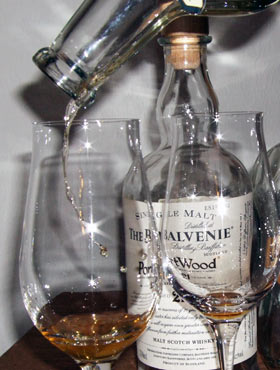 The Last Drop
The Last Drop
I have a shelf in my wine/beer cellar for my Tequila and Whisk(e)y. Everything in this space stays at a constant cool temperature. Temperature fluctuations make short work of a Scotch because of the respiration effect that happens in the bottle with heating and cooling. It's not that the Scotch will “go bad”, but it will get oxidized and lose much of its greatness. In my book, that’s plenty bad. But keeping temperatures constant has helped me to save half empty bottles of whisk(e)y for many years.
It is finally time to say goodbye to these alcoholic friends, as they are so close to the bottom that there is no chance for them to survive another couple months intact. In fact I’m sure some of them are at least somewhat oxidized. My notes here are going to include what I can remember about the times we’ve had as well as these final moments we now share.
Have you ever wondered what happens to a great single malt Scotch when it sits around too long? What about when it sits around waaaayy tooo loooong?
Let’s taste these last drops, shall we?
Series #1 We’ll start with Dalwhinnie 15 year old - I’ve had this bottle with me since at least 2003. I like Dalwhinnie because I like to chew oysters when I eat them. Whether an oyster is good or bad, Dalwhinnie is the perfect palate reset. You might think it would be better to use a big island malt like Ardbeg with iodine and salt notes, but I’ve tried many Highland, Island, Lowland & Speyside oyster pairings, and for some reason this one works the best. Michael Jackson himself mentions Dalwhinnie by name for pairing with oysters. ‘The Gentle Spirit’ is also the highest spirit, being distilled at the highest distillery in Scotland. Obviously this final quarter 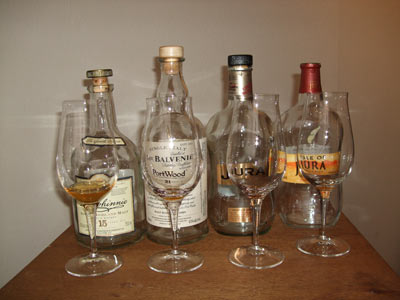 ounce isn’t looking as vibrant as in years past. It shows up a murky urine gold, rather than the bright gold/amber it used to show. Smell is muted with a slight dirty grain alcohol quality. Taste is light and bland with a slight cardboard taste and a glue-like sweet and very slightly sour taste. Obviously it’s been around long enough to lose a good amount of alcohol to the microscopic angels in the bottle. Up until this bottle dropped below the 1/3 mark it was almost perfectly stable. It seems there is no point in taking care of these babies once they get past 2/3 empty space.
ounce isn’t looking as vibrant as in years past. It shows up a murky urine gold, rather than the bright gold/amber it used to show. Smell is muted with a slight dirty grain alcohol quality. Taste is light and bland with a slight cardboard taste and a glue-like sweet and very slightly sour taste. Obviously it’s been around long enough to lose a good amount of alcohol to the microscopic angels in the bottle. Up until this bottle dropped below the 1/3 mark it was almost perfectly stable. It seems there is no point in taking care of these babies once they get past 2/3 empty space.
Next we’ll have the final sticky drop of The Balvenie PortWood 21 year old - I’ve probably had this bottle since late 2003. There’s not enough in the glass to even get a good look at the color, although it seems to look about the same as it always did except for a few dry cork bits that are floating in it. The smell (oak and port/sherry show readily) is as fresh and new as always even though this bottle has only had about 6 drops in it for the past year. I was just hanging on to it because I knew I’d eventually write this article. The taste is surprisingly alcoholic. Why did these few drops keep more character than the 1/4 ounce? Did it not have enough surface area to properly evaporate the alcohol through the surface tension? Still, the expected oxidized tastes are there, but really not too bad at all. This one was truly good to the last drop.
We’ll now take a trip to the isle of Jura to try both Jura 16 year old and 10 year old - both of these bottles have been *empty* for about 1 year. Jura is not very far from Caol Ila on the neighboring Isle of Islay, and they share many similar qualities. Although I prefer Caol Ila overall, I probably couldn’t tell them apart in a blind tasting unless I could sample them side by side. Starting with the 16, the nose is very similar to new, with big caramel and hints of vanilla and oak. There’s barely enough to taste, but it’s very similar to new. Jura usually is a lighter (read hotter) whisky, but I like the caramel of this one anyway. Still, the taste comes across as simple and the alcohol is almost totally missing in this final drop. The 10 seems like there’s nothing left to it. It tastes like water that’s had oak soaking in it. Strangely, the 16 tastes great. I think I like this last drop better than the new bottle, & again there’s some alcohol heat.
Series #2 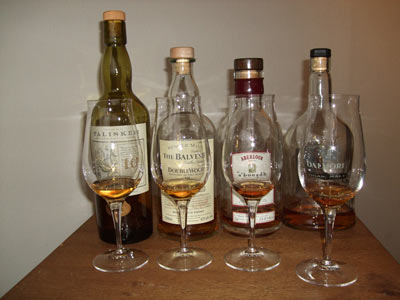 Changing gears slightly, we move to a bottle of Talisker 10 year old that I have had since 2002 and has just recently fallen to below 1/3 full. So now we’ll see how the years have treated this sleeping peat and pepper giant. The color is great, looks as good as new with a clean vibrant deep gold/faint rust. The smell is still alcohol-driven and huge, with a display of pepper, smoke and tropical fruit. Taste is almost as good as new. I sense absolutely no further oxidation beyond what a new whisky has fresh from the bottle. However, I sense a lower alcohol content and the result is a very slightly sweeter finish. Not bad, but not perfect. Time has taken a small toll.
Changing gears slightly, we move to a bottle of Talisker 10 year old that I have had since 2002 and has just recently fallen to below 1/3 full. So now we’ll see how the years have treated this sleeping peat and pepper giant. The color is great, looks as good as new with a clean vibrant deep gold/faint rust. The smell is still alcohol-driven and huge, with a display of pepper, smoke and tropical fruit. Taste is almost as good as new. I sense absolutely no further oxidation beyond what a new whisky has fresh from the bottle. However, I sense a lower alcohol content and the result is a very slightly sweeter finish. Not bad, but not perfect. Time has taken a small toll.
Next in this series is a bottle of The Balvenie DoubleWood 12 year old that’s been around since at least 2003, perhaps earlier. This Bourbon & Sherry oak blend is one of my all time favorites. I’ve always loved Macallan 18 year old matured in sherry oak, but this was the first I had ever tried that found a perfect balance between bourbon and sherry accents. The color and clarity are still close to what I’d expect, showing a slightly muted but still clean light amber. The nose is softer than it should be, exhibiting too little alcohol and too much sweetness. Oddly, it still carries a lot of strength in the flavor with only the tiniest hint of sucking at the very end where it has developed a slight postage stamp taste. The finish goes on and on after that and starts to show a little cardboard, but keep in mind that any sherry will already have these notes. My conclusion is that the major flaw here is the natural diminishment of the alcohol over time.
This next one will be interesting. I’ve got a bottle of Aberlour a’bunadh (non chill filtered) single cask Batch #10 bottled at 119.6 proof. The first time I tried this, it was as if someone had shoved a red-hot chunk of caramel corn into the back of my mouth. I could taste the shape! This thing was like candy-coated murder. Will this exhibit a noticeable loss of spirit? I can’t remember when I bought this, but it’s at least 5 years old and there’s less than 1/2 inch left in the bottle. The color is still a perfect, clear copper. The nose shows huge alcohol with caramel, sherry & leather. I can’t find anything wrong with this. I’m sure it’s lost some alcohol, but I can’t taste any flaws. So far, our winners for long-term storage are this and 21 year old Balvenie PortWood. I’m going to drink a few sips of Arrogant Bastard and try to reset my taste buds.
Last in this series is the Dalmore Cigar Malt. Again, I’m not sure of the exact age of this bottle, but it's been with me for between 5 & 8 years. I’m sure it’s the only bottle of this stuff I’ve ever bought. The color is the same burnt orange as before, while the smell is a bit vacant and lifeless. Not that there was great complexity to this one to begin with. I can still find the tea leaves on the nose though. It’s softer than before, but still just as balanced and almost as enjoyable.
Series #3 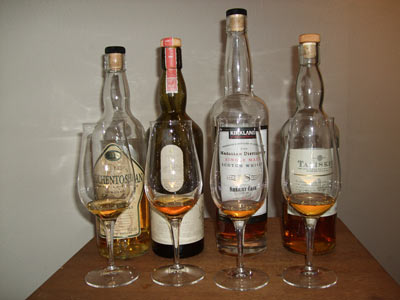 The first in this series is my only lowland malt. It’s a ‘no age statement’ bottle of the unusual triple distilled Auchentoshan. This bottle was probably purchased in 2003 and has just arrived at half empty (or half full if you’re a winner). Color is light gold & crystal clear. Smells like oil, hay and lemon & fresh cookie dough with a hint of the ocean. Taste shows some postage stamp qualities, but otherwise it’s better than I remembered.
The first in this series is my only lowland malt. It’s a ‘no age statement’ bottle of the unusual triple distilled Auchentoshan. This bottle was probably purchased in 2003 and has just arrived at half empty (or half full if you’re a winner). Color is light gold & crystal clear. Smells like oil, hay and lemon & fresh cookie dough with a hint of the ocean. Taste shows some postage stamp qualities, but otherwise it’s better than I remembered.
Now it’s time once again to totally switch gears with the heavy hitting Lagavulin 16 year old. This bottle is probably 3-4 years old. I believe I bought it for $54 during a trip to Minnesota. I haven’t seen it that cheap in a long time, even in MN. I consider this a staple, and yet I haven’t been able to empty the bottle because I simply can’t justify replenishing my stable of staples. So I’ve been nursing this dying soldier all this time. The nose has everything it should have, but the sweetness wraps around the peat smoke a bit more than it should. Taste shows that time and oxygen have done some damage, but it’s still pretty much as it should be. Plus, I’m reaching a point at which my palate is starting to numb from over-tasting.
Next on the journey to oblivion is a Kirkland-labeled Macallan 18 year old which was aged for 18 years in Bourbon oak then finished for 6 months in Sherry oak. This bottle is probably less than two years old and only recently has reached the last two inches of the bottle. I didn’t really need to taste it for this article, but it’s sooo good. This is very similar to the 25 year old sherry oak aged and way cheaper. What do you know? That reset my palate again, so I can move on.
Now we’ll be trying the Talisker 18 year old. I think I’ve had this bottle for a couple of years & it has just recently passed the 1/3 full mark. Still looks and tastes like new. Color is orange/bronze. On the nose there are candied fruit, vanilla and oak with all the spices of the 10 year old taking a back seat and just showing their presence without making a fuss. As I sip, there’s iodine that comes on just before the drink touches my tongue. Afterward I get a slight sense of chlorine that I’ve never noticed before, but that couldn’t have possibly come from age, could it?
Series #4 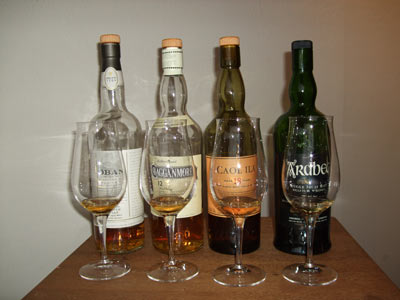 We start anew with Oban 14 year old. This another of the truly unique malts that I consider a staple. This bottle isn’t very old but it is nearly down to the 1 inch level, so it is worthy of examination in this forum. It is a clear rusty gold (as are so many). The smell is perfume and fresh rain on the seashore. The nose doesn’t really prepare one for the taste. I love Oban, but it’s one that has enough complexity to change my perception every time I taste it, even if my taste buds aren’t buzzing from numerous tastings.
We start anew with Oban 14 year old. This another of the truly unique malts that I consider a staple. This bottle isn’t very old but it is nearly down to the 1 inch level, so it is worthy of examination in this forum. It is a clear rusty gold (as are so many). The smell is perfume and fresh rain on the seashore. The nose doesn’t really prepare one for the taste. I love Oban, but it’s one that has enough complexity to change my perception every time I taste it, even if my taste buds aren’t buzzing from numerous tastings.
Since we’re in the perfume camp, I thought Cragganmore 12 year old should naturally follow Oban. I have no idea how long I’ve owned this bottle. Suffice it to say it has been quite some time. This bottle is below 1/3 full and has been there for quite some time. It still has the same clean pale orange as always. The aromatics of fresh flowers have certainly dropped out a bit, but it now shows more tropical fruit. Taste is primarily still herbal with hints of lavender, sage & lemon thyme intermingled with fresh hay with a long finish showing hints of oaky vanilla and tea leaves.
I’ve already mentioned Caol Ila, the next island neighbor to Jura. Well, now we’re going to try it. Here we have an 18 year old example, which I consider to be a big brother to Jura. Everything is bigger and shows more experience. Color is yellow to light orange. The nose shows big peat smoke (not Laphroaig big, but plenty big), and oceanic notes along with spice. The taste continues the story with pepper and oil, leaving an oily residue on the tongue lengthening the experience considerably. It’s more than a minute since that sip and I’m still feeling and tasting it. Funny, I’ve always liked Caol Ila, but in this tasting I’m realizing for the first time that it needs to be higher on my list. I can’t afford my current list of staples. And now another!
Staying on Islay, we’re moving over to Ardbeg 10 year old. A single malt I don’t think I can live without. On the surface it shows a battle royale between peat bog and ocean that is plenty exciting. But when you peek below the fray you see waves of complex beauty. This bottle is one of many that I’ve had over the years. My friend Tom Granberg used to always come over to my place in Phoenix and drink my Ardbeg. Then some sort of wacky magic happened. Once I moved to the middle of nowhere, Tom G. would come by on occasional visits, always bearing a gift of Ardbeg. I’m sure he must have repaid his Ardbeg debt by now, but I don’t really keep track of such things. The appearance is the pale yellow of a light white wine with a hint of green. The nose is like gasping for air after climbing out of a turbid ocean only to find that your head is buried in a burning peat bog. If you’re not prepared for it, the smell is like suffocating in a pile of dirty socks. As it applies to the drink itself, those illustrative deaths will bring you to this true heaven...they’re worth it. I recommend buying a bottle of Lagavulin and a bottle of Ardbeg at the same time so you can try this: drink the Lagavulin first to remove the peat and sweetness from the Ardbeg and experience the waves of flavor that lie beneath. You might also get a great effect by using Laphroaig as the peat blocking agent. There are so many wonderful things happening in this drop that I’ve saved it for last.
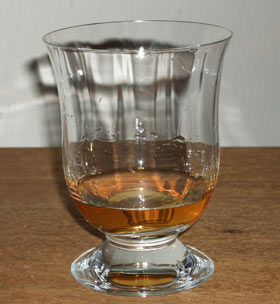 But there is one final drop. All the leftovers from this tasting have been put into a single glass. Let’s see how that drop of last drops tastes. First of all the color is a rusty orange. The nose is surprisingly austere for all the great stuff in here. Perhaps it isn’t so much austere as unified, either way -- it’s unexpected. Tastes like crap. Just kidding. Actually, it just tastes bizarre, but not in a bad way. It’s just all over the map and it doesn’t want to combine into any one thing.
But there is one final drop. All the leftovers from this tasting have been put into a single glass. Let’s see how that drop of last drops tastes. First of all the color is a rusty orange. The nose is surprisingly austere for all the great stuff in here. Perhaps it isn’t so much austere as unified, either way -- it’s unexpected. Tastes like crap. Just kidding. Actually, it just tastes bizarre, but not in a bad way. It’s just all over the map and it doesn’t want to combine into any one thing.
“The Final Blend”
Three days later - I’m back to check on that blend and see how it has integrated. Actually, it smells quite good, but the aroma has veered heavily toward the the Islay qualities of Ardbeg and Lagavulin. Now that the taste has integrated a bit it’s quite good! The malts that shine out are Ardbeg, Lagavulin, Cragganmore & Macallan in that order.
Here’s a group photo of the players who live to play another day, some just barely, some just because they are still liquid.
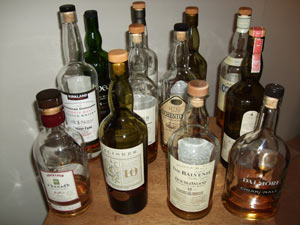
--Thomas Ale Johnson The last drop May 26th 2010